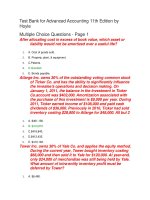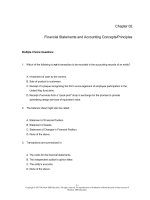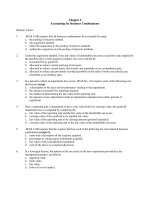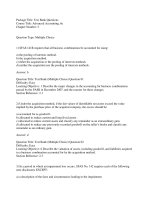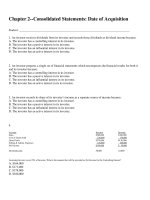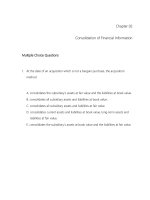Advanced accounting 11th edition hoyle test bank
Bạn đang xem bản rút gọn của tài liệu. Xem và tải ngay bản đầy đủ của tài liệu tại đây (5.25 MB, 338 trang )
Chapter 02
Consolidation of Financial Information
Multiple Choice Questions
1. At the date of an acquisition which is not a bargain purchase, the acquisition
method
A. consolidates the subsidiary's assets at fair value and the liabilities at book value.
B. consolidates all subsidiary assets and liabilities at book value.
C. consolidates all subsidiary assets and liabilities at fair value.
D. consolidates current assets and liabilities at book value, long-term assets and
liabilities at fair value.
E. consolidates the subsidiary's assets at book value and the liabilities at fair value.
2. In an acquisition where control is achieved, how would the land accounts of the
parent and the land accounts of the subsidiary be combined?
A. Option A
B. Option B
C. Option C
D. Option D
E. Option E
3. Lisa Co. paid cash for all of the voting common stock of Victoria Corp. Victoria will
continue to exist as a separate corporation. Entries for the consolidation of Lisa
and Victoria would be recorded in
A. a worksheet.
B. Lisa's general journal.
C. Victoria's general journal.
D. Victoria's secret consolidation journal.
E. the general journals of both companies.
4. Using the acquisition method for a business combination, goodwill is generally
defined as:
A. Cost of the investment less the subsidiary's book value at the beginning of the
year.
B. Cost of the investment less the subsidiary's book value at the acquisition date.
C. Cost of the investment less the subsidiary's fair value at the beginning of the
year.
D. Cost of the investment less the subsidiary's fair value at acquisition date.
E. is no longer allowed under federal law.
5. Direct combination costs and stock issuance costs are often incurred in the
process of making a controlling investment in another company. How should
those costs be accounted for in a pre-2009 purchase transaction?
A. Option A
B. Option B
C. Option C
D. Option D
E. Option E
6. How are direct and indirect costs accounted for when applying the acquisition
method for a business combination?
A. Option A
B. Option B
C. Option C
D. Option D
E. Option E
7. What is the primary accounting difference between accounting for when the
subsidiary is dissolved and when the subsidiary retains its incorporation?
A. If the subsidiary is dissolved, it will not be operated as a separate division.
B. If the subsidiary is dissolved, assets and liabilities are consolidated at their book
values.
C. If the subsidiary retains its incorporation, there will be no goodwill associated
with the acquisition.
D. If the subsidiary retains its incorporation, assets and liabilities are consolidated
at their book values.
E. If the subsidiary retains its incorporation, the consolidation is not formally
recorded in the accounting records of the acquiring company.
8. According to GAAP, the pooling of interest method for business combinations
A. Is preferred to the purchase method.
B. Is allowed for all new acquisitions.
C. Is no longer allowed for business combinations after June 30, 2001.
D. Is no longer allowed for business combinations after December 31, 2001.
E. Is only allowed for large corporate mergers like Exxon and Mobil.
9. An example of a difference in types of business combination is:
A. A statutory merger can only be effected by an asset acquisition while a
statutory consolidation can only be effected by a capital stock acquisition.
B. A statutory merger can only be effected by a capital stock acquisition while a
statutory consolidation can only be effected by an asset acquisition.
C. A statutory merger requires dissolution of the acquired company while a
statutory consolidation does not require dissolution.
D. A statutory consolidation requires dissolution of the acquired company while a
statutory merger does not require dissolution.
E. Both a statutory merger and a statutory consolidation can only be effected by
an asset acquisition but only a statutory consolidation requires dissolution of
the acquired company.
10. Acquired in-process research and development is considered as
A. a definite-lived asset subject to amortization.
B. a definite-lived asset subject to testing for impairment.
C. an indefinite-lived asset subject to amortization.
D. an indefinite-lived asset subject to testing for impairment.
E. a research and development expense at the date of acquisition.
11. Which one of the following is a characteristic of a business combination
accounted for as an acquisition?
A. The combination must involve the exchange of equity securities only.
B. The transaction establishes an acquisition fair value basis for the company
being acquired.
C. The two companies may be about the same size, and it is difficult to determine
the acquired company and the acquiring company.
D. The transaction may be considered to be the uniting of the ownership interests
of the companies involved.
E. The acquired subsidiary must be smaller in size than the acquiring parent.
12. Which one of the following is a characteristic of a business combination that is
accounted for as an acquisition?
A. Fair value only for items received by the acquirer can enter into the
determination of the acquirer's accounting valuation of the acquired company.
B. Fair value only for the consideration transferred by the acquirer can enter into
the determination of the acquirer's accounting valuation of the acquired
company.
C. Fair value for the consideration transferred by the acquirer as well as the fair
value of items received by the acquirer can enter into the determination of the
acquirer's accounting valuation of the acquired company.
D. Fair value for only consideration transferred and identifiable assets received by
the acquirer can enter into the determination of the acquirer's accounting
valuation of the acquired company.
E. Only fair value of identifiable assets received enters into the determination of
the acquirer's accounting valuation of the acquired company.
13. A statutory merger is a(n)
A. business combination in which only one of the two companies continues to
exist as a legal corporation.
B. business combination in which both companies continues to exist.
C. acquisition of a competitor.
D. acquisition of a supplier or a customer.
E. legal proposal to acquire outstanding shares of the target's stock.
14. How are stock issuance costs and direct combination costs treated in a business
combination which is accounted for as an acquisition when the subsidiary will
retain its incorporation?
A. Stock issuance costs are a part of the acquisition costs, and the direct
combination costs are expensed.
B. Direct combination costs are a part of the acquisition costs, and the stock
issuance costs are a reduction to additional paid-in capital.
C. Direct combination costs are expensed and stock issuance costs are a reduction
to additional paid-in capital.
D. Both are treated as part of the acquisition consideration transferred.
E. Both are treated as a reduction to additional paid-in capital.
15. Bullen Inc. acquired 100% of the voting common stock of Vicker Inc. on January 1,
20X1. The book value and fair value of Vicker's accounts on that date (prior to
creating the combination) follow, along with the book value of Bullen's accounts:
Assume that Bullen issued 12,000 shares of common stock with a $5 par value and
a $47 fair value to obtain all of Vicker's outstanding stock. In this acquisition
transaction, how much goodwill should be recognized?
A. $144,000.
B. $104,000.
C. $64,000.
D. $60,000.
E. $0.
16. Bullen Inc. acquired 100% of the voting common stock of Vicker Inc. on January 1,
20X1. The book value and fair value of Vicker's accounts on that date (prior to
creating the combination) follow, along with the book value of Bullen's accounts:
Assume that Bullen issued 12,000 shares of common stock with a $5 par value and
a $42 fair value for all of the outstanding stock of Vicker. What is the consolidated
balance for Land as a result of this acquisition transaction?
A. $460,000.
B. $510,000.
C. $500,000.
D. $520,000.
E. $490,000.
17. Bullen Inc. acquired 100% of the voting common stock of Vicker Inc. on January 1,
20X1. The book value and fair value of Vicker's accounts on that date (prior to
creating the combination) follow, along with the book value of Bullen's accounts:
Assume that Bullen issued 12,000 shares of common stock with a $5 par value and
a $42 fair value for all of the outstanding shares of Vicker. What will be the
consolidated Additional Paid-In Capital and Retained Earnings (January 1, 20X1
balances) as a result of this acquisition transaction?
A. $60,000 and $490,000.
B. $60,000 and $250,000.
C. $380,000 and $250,000.
D. $464,000 and $250,000.
E. $464,000 and $420,000.
18. Bullen Inc. acquired 100% of the voting common stock of Vicker Inc. on January 1,
20X1. The book value and fair value of Vicker's accounts on that date (prior to
creating the combination) follow, along with the book value of Bullen's accounts:
Assume that Bullen issued preferred stock with a par value of $240,000 and a fair
value of $500,000 for all of the outstanding shares of Vicker in an acquisition
business combination. What will be the balance in the consolidated Inventory and
Land accounts?
A. $440,000, $496,000.
B. $440,000, $520,000.
C. $425,000, $505,000.
D. $400,000, $500,000.
E. $427,000, $510,000.
19. Bullen Inc. acquired 100% of the voting common stock of Vicker Inc. on January 1,
20X1. The book value and fair value of Vicker's accounts on that date (prior to
creating the combination) follow, along with the book value of Bullen's accounts:
Assume that Bullen paid a total of $480,000 in cash for all of the shares of Vicker.
In addition, Bullen paid $35,000 for secretarial and management time allocated to
the acquisition transaction. What will be the balance in consolidated goodwill?
A. $0.
B. $20,000.
C. $35,000.
D. $55,000.
E. $65,000.
20. Bullen Inc. acquired 100% of the voting common stock of Vicker Inc. on January 1,
20X1. The book value and fair value of Vicker's accounts on that date (prior to
creating the combination) follow, along with the book value of Bullen's accounts:
Assume that Bullen paid a total of $480,000 in cash for all of the shares of Vicker.
In addition, Bullen paid $35,000 to a group of attorneys for their work in arranging
the combination to be accounted for as an acquisition. What will be the balance in
consolidated goodwill?
A. $0.
B. $20,000.
C. $35,000.
D. $55,000.
E. $65,000
21. Prior to being united in a business combination, Botkins Inc. and Volkerson Corp.
had the following stockholders' equity figures:
Botkins issued 56,000 new shares of its common stock valued at $3.25 per share
for all of the outstanding stock of Volkerson.
Assume that Botkins acquired Volkerson on January 1, 2010. At what amount did
Botkins record the investment in Volkerson?
A. $56,000.
B. $182,000.
C. $209,000.
D. $261,000.
E. $312,000.
22. Prior to being united in a business combination, Botkins Inc. and Volkerson Corp.
had the following stockholders' equity figures:
Botkins issued 56,000 new shares of its common stock valued at $3.25 per share
for all of the outstanding stock of Volkerson.
Assume that Botkins acquired Volkerson on January 1, 2010. Immediately
afterwards, what is consolidated Common Stock?
A. $456,000.
B. $402,000.
C. $274,000.
D. $276,000.
E. $330,000.
23. Chapel Hill Company had common stock of $350,000 and retained earnings of
$490,000. Blue Town Inc. had common stock of $700,000 and retained earnings of
$980,000. On January 1, 2011, Blue Town issued 34,000 shares of common stock
with a $12 par value and a $35 fair value for all of Chapel Hill Company's
outstanding common stock. This combination was accounted for as an acquisition.
Immediately after the combination, what was the total consolidated net assets?
A. $2,520,000.
B. $1,190,000.
C. $1,680,000.
D. $2,870,000.
E. $2,030,000.
24. Which of the following is a not a reason for a business combination to take place?
A. Cost savings through elimination of duplicate facilities.
B. Quick entry for new and existing products into domestic and foreign markets.
C. Diversification of business risk.
D. Vertical integration.
E. Increase in stock price of the acquired company.
25. Which of the following statements is true regarding a statutory merger?
A. The original companies dissolve while remaining as separate divisions of a
newly created company.
B. Both companies remain in existence as legal corporations with one corporation
now a subsidiary of the acquiring company.
C. The acquired company dissolves as a separate corporation and becomes a
division of the acquiring company.
D. The acquiring company acquires the stock of the acquired company as an
investment.
E. A statutory merger is no longer a legal option.
26. Which of the following statements is true regarding a statutory consolidation?
A. The original companies dissolve while remaining as separate divisions of a
newly created company.
B. Both companies remain in existence as legal corporations with one corporation
now a subsidiary of the acquiring company.
C. The acquired company dissolves as a separate corporation and becomes a
division of the acquiring company.
D. The acquiring company acquires the stock of the acquired company as an
investment.
E. A statutory consolidation is no longer a legal option.
27. In a transaction accounted for using the acquisition method where consideration
transferred exceeds book value of the acquired company, which statement is true
for the acquiring company with regard to its investment?
A. Net assets of the acquired company are revalued to their fair values and any
excess of consideration transferred over fair value of net assets acquired is
allocated to goodwill.
B. Net assets of the acquired company are maintained at book value and any
excess of consideration transferred over book value of net assets acquired is
allocated to goodwill.
C. Acquired assets are revalued to their fair values. Acquired liabilities are
maintained at book values. Any excess is allocated to goodwill.
D. Acquired long-term assets are revalued to their fair values. Any excess is
allocated to goodwill.
28. In a transaction accounted for using the acquisition method where consideration
transferred is less than fair value of net assets acquired, which statement is true?
A. Negative goodwill is recorded.
B. A deferred credit is recorded.
C. A gain on bargain purchase is recorded.
D. Long-term assets of the acquired company are reduced in proportion to their
fair values. Any excess is recorded as a deferred credit.
E. Long-term assets and liabilities of the acquired company are reduced in
proportion to their fair values. Any excess is recorded as an extraordinary gain.
29. Which of the following statements is true regarding the acquisition method of
accounting for a business combination?
A. Net assets of the acquired company are reported at their fair values.
B. Net assets of the acquired company are reported at their book values.
C. Any goodwill associated with the acquisition is reported as a development cost.
D. The acquisition can only be effected by a mutual exchange of voting common
stock.
E. Indirect costs of the combination reduce additional paid-in capital.
30. Which of the following statements is true?
A. The pooling of interests for business combinations is an alternative to the
acquisition method.
B. The purchase method for business combinations is an alternative to the
acquisition method.
C. Neither the purchase method nor the pooling of interests method is allowed
for new business combinations.
D. Any previous business combination originally accounted for under purchase or
pooling of interests accounting method will now be accounted for under the
acquisition method of accounting for business combinations.
E. Companies previously using the purchase or pooling of interests accounting
method must report a change in accounting principle when consolidating those
subsidiaries with new acquisition combinations.
31. The financial statements for Goodwin, Inc., and Corr Company for the year ended
December 31, 20X1, prior to Goodwin's acquisition business combination
transaction regarding Corr, follow (in thousands):
On December 31, 20X1, Goodwin issued $600 in debt and 30 shares of its $10 par
value common stock to the owners of Corr to acquire all of the outstanding
shares of that company. Goodwin shares had a fair value of $40 per share.
Goodwin paid $25 to a broker for arranging the transaction. Goodwin paid $35 in
stock issuance costs. Corr's equipment was actually worth $1,400 but its buildings
were only valued at $560.
In this acquisition business combination, at what amount is the investment
recorded on Goodwin's books?
A. $1,540.
B. $1,800.
C. $1,860.
D. $1,825.
E. $1,625.
32. The financial statements for Goodwin, Inc., and Corr Company for the year ended
December 31, 20X1, prior to Goodwin's acquisition business combination
transaction regarding Corr, follow (in thousands):
On December 31, 20X1, Goodwin issued $600 in debt and 30 shares of its $10 par
value common stock to the owners of Corr to acquire all of the outstanding
shares of that company. Goodwin shares had a fair value of $40 per share.
Goodwin paid $25 to a broker for arranging the transaction. Goodwin paid $35 in
stock issuance costs. Corr's equipment was actually worth $1,400 but its buildings
were only valued at $560.
In this acquisition business combination, what total amount of common stock and
additional paid-in capital is recorded on Goodwin's books?
A. $265.
B. $1,165.
C. $1,200.
D. $1,235.
E. $1,765.

